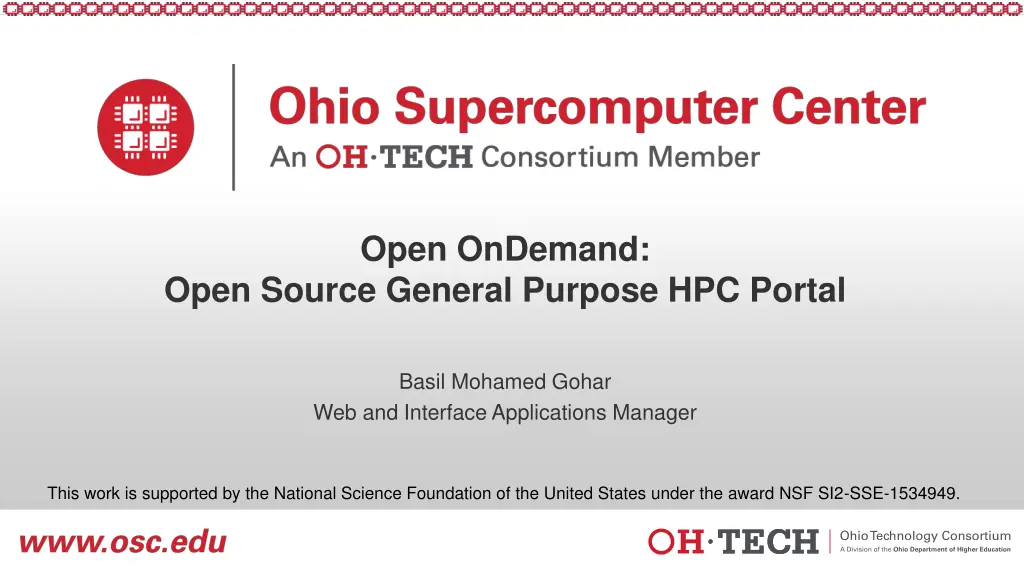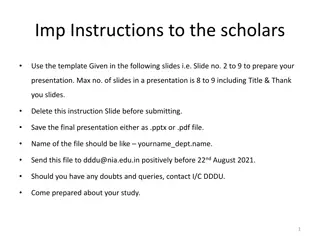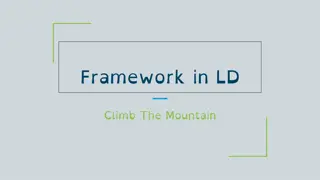
Open OnDemand: General Purpose HPC Portal Overview
"Explore the open-source project Open OnDemand, supported by the National Science Foundation, offering a versatile HPC portal that can be installed for various settings. Learn about its features, installation procedure, and site integration for a seamless user experience."
Download Presentation

Please find below an Image/Link to download the presentation.
The content on the website is provided AS IS for your information and personal use only. It may not be sold, licensed, or shared on other websites without obtaining consent from the author. If you encounter any issues during the download, it is possible that the publisher has removed the file from their server.
You are allowed to download the files provided on this website for personal or commercial use, subject to the condition that they are used lawfully. All files are the property of their respective owners.
The content on the website is provided AS IS for your information and personal use only. It may not be sold, licensed, or shared on other websites without obtaining consent from the author.
E N D
Presentation Transcript
Open OnDemand: Open Source General Purpose HPC Portal Basil Mohamed Gohar Web and Interface Applications Manager This work is supported by the National Science Foundation of the United States under the award NSF SI2-SSE-1534949. Slide 1
Open OnDemand Overview About Open OnDemand Using Apps How does it work? Installation Procedure Site Integration Extending the Platform Slide 2
About Open OnDemand Open source software project Installable for an HPC cluster (or clusters) Standalone system, Lab, Department, University or National Resources More than just an out of the box solution OnDemand is a platform that can be extended through additional and custom apps Slide 3
OnDemand Features Single point of entry for HPC Center s services User needs three things URL: ondemand.xxx.edu Username Password Zero install (Completely browser based) Single sign-on Firewall friendly (Keep traffic on https port) Slide 4
Open OnDemand Overview About Open OnDemand Using Apps How does it work? Installation Procedure Site Integration Extending the Platform Slide 5
Open OnDemand App Features App Features Dashboard File Browser File Editor Terminal My Jobs Active Jobs Browse and Launch Apps. Browse directories. Upload/Download. Move and Rename. Multiple themes. Key bindings. Syntax highlighting. SSH session to login node. Create and submit jobs to cluster. Display job queue. Slide 6
Open OnDemand App Features Interactive Demo #1 Slide 7
Open OnDemand Overview About Open OnDemand Using Apps How does it work? Installation Procedure Site Integration Extending the Platform Slide 8
How does it work? Our View of the World Clients connect to login node through SSH Interact with batch system and shared file system through the bash user process Slide 9
How does it work? We introduced an OnDemand server Similar to a traditional login node Same authentication Talks to the same resource manager Mounts the same shared file system Slide 10
How does it work? Now clients may also connect to OnDemand server through browser The httpd proxy starts up a per-user nginx (PUN) process for each user The PUN launches apps as children processes Slide 11
How does it work? The Files App launches as the user under the PUN Interacts with the shared file system through the Node.js fs core library File permissions are maintained as all processes run as user Slide 12
How does it work? The Shell App launches as the user under the PUN Within the shell app an ssh process is started connecting to the login node The browser behaves as the terminal for the ssh process Slide 13
How does it work? The Active Jobs App launches as the user under the PUN Interacts with a Torque batch server Equivalent to a qstat command called by the user Slide 14
How does it work? The My Jobs App launches as the user under the PUN Submits jobs to Torque batch server Writes input files and reads output files generated by batch jobs through shared file system Slide 15
Open OnDemand Overview About Open OnDemand Using Apps How does it work? Installation Procedure Site Integration Extending the Platform Slide 16
Installation Procedure Installation steps limited to OnDemand server Install system dependencies Apache, Ruby, NodeJS, Passenger, git (we use Software Collections) Client libraries for authentication, resource manager, and shared file system access (like any login node) Install Open OnDemand infrastructure from GitHub Sets up web server to run apps Install Open OnDemand apps from GitHub Dashboard, Shell, Files, Editor, Active Jobs, My Jobs https://osc.github.io/Open-OnDemand/installation Slide 17
Open OnDemand Overview About Open OnDemand Using Apps How does it work? Installation Procedure Site Integration Extending the Platform Slide 18
Site Integration Authentication setup Connect to existing user directory (LDAP) Federated authentication (CILogon) OpenID Connect (CILogon, Keycloak) Shibboleth Batch setup PBS/TORQUE SLURM and LSF sites needed, we want to work with you Slide 19
Open OnDemand Overview About Open OnDemand Using Apps How does it work? Installation Procedure Site Integration Extending the Platform Slide 20
Extending the Platform Vision: not just to provide these 6 apps, but to create a platform so any HPC user can build an app All apps in Open OnDemand are Phusion Passenger apps Using Passenger app server, Open OnDemand lets a developer drop a new app s files into a directory and access it via a URL without requiring a manual server configuration or restart NOTE: certain app changes may require a user-initiated app restart Ruby, Node.js, Python-based apps are supported Any user can write an app and use it without any help from the sys admin Sys admin can deploy any app so that everyone can access it through the dashboard Slide 21
Extending the Platform: Creating an App 1. Drop an app in $HOME $HOME/ondemand/dev/APP 2. Install app specific dependencies (if any) in app subdirectory 3. Access app via URL https://ondemand.xxx.edu/pun/dev/APP Slide 22
Extending the Platform: Publishing an App 1. Add dashboard configuration manifest.yml file $HOME/ondemand/dev/APP/manifest.yml 2. Copy app to production location /var/www/ood/apps/sys/APP 3. Access dashboard (may require reload) Slide 23
Getting Open OnDemand Installed at your Center If your already run EL and PBS/TORQUE, you can download and install Open OnDemand now and try for yourself If not, then we can try to work with you to get Open OnDemand extended to support your setup Tell us how we can help! Slide 24
Next Webinar/Staying in Touch Our webinars are planned roughly quarterly Let us know what you d like to learn about next Visit our website https://osc.github.io/Open-OnDemand/ Join our mailing list https://lists.osu.edu/mailman/listinfo/ood-users Get Open OnDemand! https://github.com/OSC/Open-OnDemand Slide 25
Thank you! Any questions? Basil Mohamed Gohar Web and Interface Applications Manager Ohio Supercomputer Center bgohar@osc.edu https://osc.github.io/Open-OnDemand/ go.osu.edu/ood Slide 26






















